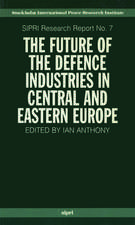Reducing Threats at the Source: A European Perspective on Cooperative Threat Reduction: SIPRI Research Reports, cartea 19
Autor Ian Anthonyen Limba Engleză Paperback – 21 apr 2004
examines how European countries might organize their cooperative threat reduction activities to increase their coherence and effectiveness.
| Toate formatele și edițiile | Preț | Express |
|---|---|---|
| Paperback (1) | 275.79 lei 31-37 zile | |
| OUP OXFORD – 21 apr 2004 | 275.79 lei 31-37 zile | |
| Hardback (1) | 638.01 lei 31-37 zile | |
| OUP OXFORD – 6 mai 2004 | 638.01 lei 31-37 zile |
Din seria SIPRI Research Reports
- 30%
 Preț: 495.62 lei
Preț: 495.62 lei - 45%
 Preț: 442.48 lei
Preț: 442.48 lei - 23%
 Preț: 166.60 lei
Preț: 166.60 lei - 41%
 Preț: 148.66 lei
Preț: 148.66 lei - 23%
 Preț: 329.69 lei
Preț: 329.69 lei - 23%
 Preț: 131.76 lei
Preț: 131.76 lei - 14%
 Preț: 189.07 lei
Preț: 189.07 lei - 31%
 Preț: 326.11 lei
Preț: 326.11 lei - 32%
 Preț: 267.40 lei
Preț: 267.40 lei - 24%
 Preț: 157.13 lei
Preț: 157.13 lei - 37%
 Preț: 194.53 lei
Preț: 194.53 lei - 20%
 Preț: 252.20 lei
Preț: 252.20 lei - 36%
 Preț: 166.60 lei
Preț: 166.60 lei - 10%
 Preț: 278.06 lei
Preț: 278.06 lei - 9%
 Preț: 301.97 lei
Preț: 301.97 lei - 24%
 Preț: 244.99 lei
Preț: 244.99 lei - 58%
 Preț: 89.95 lei
Preț: 89.95 lei - 11%
 Preț: 226.15 lei
Preț: 226.15 lei - 30%
 Preț: 531.24 lei
Preț: 531.24 lei - 43%
 Preț: 147.21 lei
Preț: 147.21 lei - 32%
 Preț: 266.42 lei
Preț: 266.42 lei -
 Preț: 162.04 lei
Preț: 162.04 lei - 39%
 Preț: 335.21 lei
Preț: 335.21 lei - 39%
 Preț: 255.19 lei
Preț: 255.19 lei
Preț: 275.79 lei
Preț vechi: 308.64 lei
-11% Nou
Puncte Express: 414
Preț estimativ în valută:
52.77€ • 55.25$ • 43.67£
52.77€ • 55.25$ • 43.67£
Carte tipărită la comandă
Livrare economică 27 martie-02 aprilie
Preluare comenzi: 021 569.72.76
Specificații
ISBN-13: 9780199271788
ISBN-10: 019927178X
Pagini: 132
Ilustrații: 2 tables
Dimensiuni: 138 x 216 x 8 mm
Greutate: 0.19 kg
Editura: OUP OXFORD
Colecția OUP Oxford
Seria SIPRI Research Reports
Locul publicării:Oxford, United Kingdom
ISBN-10: 019927178X
Pagini: 132
Ilustrații: 2 tables
Dimensiuni: 138 x 216 x 8 mm
Greutate: 0.19 kg
Editura: OUP OXFORD
Colecția OUP Oxford
Seria SIPRI Research Reports
Locul publicării:Oxford, United Kingdom
Descriere
Descriere de la o altă ediție sau format:
In 2002 the Group of Eight industrialized nations - in which Canada, France, Germany, Italy, Japan, Russia, the UK, the USA and representatives of the European Union participate - formed the Global Partnership Against the Spread of Weapons and Materials of Mass Destruction. The G8 pledged to raise up to $20 billion to carry out the Global Partnership projects over a 10-year period, initially in Russia but with the intention to expand the scope of projects to include other countries. These projects will help to specify the quantities and locations of weapons and materials and ensure that stocks are held under safe and secure custody to prevent diversion to unauthorized users or inappropriate uses. If the weapons or materials are not required, this practical assistance can also help to eliminate the surplus.The G8 initiative is only one of a number of activities sharing the same basic features: tailor-made measures jointly implemented on the territory of one state by a coalition including states, international organizations, local and regional governments, non-governmental organizations and the private sector. This report reviews the current cooperative threat reduction activities with a particular focus on projects and approaches engaging European partners. It examines the organizing principles for cooperative threat reduction and the lessons learned from past project implementation. Finally, it examines how European countries might organize their cooperative threat reduction activities to increase their coherence and effectiveness.
In 2002 the Group of Eight industrialized nations - in which Canada, France, Germany, Italy, Japan, Russia, the UK, the USA and representatives of the European Union participate - formed the Global Partnership Against the Spread of Weapons and Materials of Mass Destruction. The G8 pledged to raise up to $20 billion to carry out the Global Partnership projects over a 10-year period, initially in Russia but with the intention to expand the scope of projects to include other countries. These projects will help to specify the quantities and locations of weapons and materials and ensure that stocks are held under safe and secure custody to prevent diversion to unauthorized users or inappropriate uses. If the weapons or materials are not required, this practical assistance can also help to eliminate the surplus.The G8 initiative is only one of a number of activities sharing the same basic features: tailor-made measures jointly implemented on the territory of one state by a coalition including states, international organizations, local and regional governments, non-governmental organizations and the private sector. This report reviews the current cooperative threat reduction activities with a particular focus on projects and approaches engaging European partners. It examines the organizing principles for cooperative threat reduction and the lessons learned from past project implementation. Finally, it examines how European countries might organize their cooperative threat reduction activities to increase their coherence and effectiveness.












